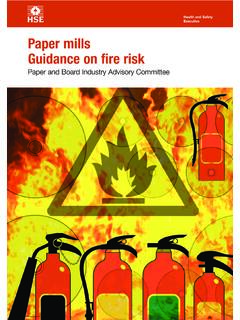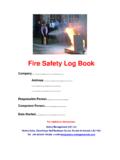Transcription of for the protection of empty buildings: fire safety and ...
1 For the protection ofempty buildings: fire safety andsecurityFPAFire ProtectionAssociationIn association withAGL_Ch01_Code of Practice. #271 16/4/09 15:13 Page 1 Code of PracticeFOR THE protection OF empty BUILDINGS: fire safety AND SECURITYIMPORTANT NOTICEThis document has been developed through the Insurers fire Research Strategy scheme (InFiReS) and published bythe fire protection Association (FPA). InFiReS membershipcomprises a group of UK insurers that actively support anumber of expert working groups developing andpromulgating best practice for the protection of people,property, business and the environment from loss due to fireand other risks. The technical expertise for this documenthas been provided by the Technical Directorate of the FPA,external consultants, and experts from the insuranceindustry who together form the various InFiReS SteeringGroups.
2 Although produced with insurer input it does not(and is not intended to) represent a pan-insurer insurance companies will have their ownrequirements which may be different from or not reflectedin the content of this FPA has made extensive efforts to check the accuracy ofthe information and advice contained in this document andit is believed to be accurate at the time of printing However,the FPA makes no guarantee, representation or warranty(express or implied) as to the accuracy or completeness ofany information or advice contained in this document. Alladvice and recommendations are presented in good faith onthe basis of information, knowledge and technology as at thedate of publication of this prejudice to the generality of the foregoing, the FPAmakes no guarantee, representation or warranty (express orimplied) that this document considers all systems, equipmentand procedures or state of the art technologies current at thedate of this of, or reliance upon, this document or any part of itscontent is voluntary and is at the user s own risk.
3 Anyoneconsidering using or implementing any recommendation oradvice within this document should rely on his or her ownpersonal judgement or, as appropriate, seek the advice of acompetent professional and rely on that professional sadvice. Nothing in this document replaces or excludes (noris intended to replace or exclude) entirely or in partmandatory and/or legal requirements howsoever arising(including without prejudice to the generality of theforegoing any such requirements for maintaining health andsafety in the workplace).Except to the extent that it is unlawful to exclude any liability,the FPA accepts no liability whatsoever for any direct, in-direct or consequential loss or damage arising in any way fromthe publication of this document or any part of it or any useof or reliance placed on the content of this document or anypart of published by The fire protection Association,London Road, Moreton in Marsh, GloucestershireGL56 0 RHTel: 01608 812500 Fax: 01608 812501 Email: The fire protection Association 2008 on behalf ofInsurers fire Research StrategyPrinted By Alden Press of other publications on loss control are available from the FPA at London Road,Moreton in Marsh, Gloucestershire GL56 0RH.
4 Copies ofpublications can be downloaded free of charge purchased from the FPA bycalling +44 (0)1608 812500 or emailing Technical contact:Adair LewisEmail: of Practice. #271 16/4/09 15:13 Page 2 Code of PracticeFOR THE protection OF empty BUILDINGS: fire safety AND SECURITY3 CONTENTSI ntroduction4 Scope4 Synopsis4 Section 1 The extent of the problem5 Section 2 Managing the shutdown5 Section 3 fire and empty buildings6 Section 4 Information for the fire service6 Section 5 Temporary use of empty buildings7 Section 6 Adjacent property8 Section 7 General precautions8 Section 8 security precautions Perimeter Physical security Electronic security Manned guarding services11 Section 9 Insurers requirements12 Section 10 Liaison with the police 13 Section 11 Legal liability 13 Section 12 Management checklist14 Appendix A: Historic buildings17 References18 AGL_Ch01_Code of Practice.
5 #271 16/4/09 15:13 Page 34 Code of PracticeFOR THE protection OF empty BUILDINGS: fire safety AND SECURITYB uildings need appropriate protection at all stages oftheir life, from construction through to eventualdemolition. Although empty buildings are always atrisk from various forms of criminal activity anddeterioration, the risks increase if the building is leftempty for any length of Buildings become empty for many reasons, for exampleduring and following construction/refurbishment,awaiting letting, or pending sale or demolition. Sensibleprecautions taken at the time a building becomes emptyand subsequent follow-up action will minimise the riskof loss or document provides guidance to those responsiblefor any empty premises. It is aimed at buildings whichare temporarily empty and are still seen by the ownersas having a viable future.
6 It also provides guidance thatmay be applied to buildings whose future is less 12 of this document contains a generalchecklist of actions for owners of empty buildings, partsof which are extracted and commented upon within themain A contains specific advice about emptybuildings of architectural or historical significance,where special considerations may apply. In such cases,consultation with the appropriate authorities way of clarification, and to avoid unnecessaryrepetition/qualification within the body of thisdocument, the following terms are considered to mean: owners those responsible for the empty to the circumstances of the building , thiscould be those who own the building , leaseholders,tenants, or managing agents and their staff; building (s) land and any structure/property builtupon it, plus any contents within.
7 And empty building (s) buildings that, to all intents andpurposes, are not being used as a workplace, store oras it is not possible to address every type ofsituation in detail in this document, the guidancepresented, if adopted sensibly by owners, will reducelosses from empty buildings, whether due to theft,vandalism or deliberate fire raising (arson). AGL_Ch01_Code of Practice. #271 16/4/09 15:13 Page 4 Code of PracticeFOR THE protection OF empty BUILDINGS: fire safety AND SECURITY5 The surveillance and care exercised through the normaloccupation of a building contributes to its security andfire safety , but in the case of an empty building thisprotection will not be available. Although detailedrecords of all fires in unoccupied buildings within theUK are not available, many insurers report verysignificant fire and theft losses from such buildings onan annual basis.
8 In addition to insured loss must beadded the non-insured costs incurred by owners, andalso society generally in respect of the attendance of theemergency services and the environmental impact offire water run-off and in empty buildings may have a number ofmotives: to steal any contents; to strip the buildings of any metal, eg roofingmaterials, flashings, electrical wiring or equipment(switchgear/transformers, etc) or plumbing(pipework, radiators, boilers, etc); to strip the buildings of any architectural fixturesand fittings, eg fireplaces, doors;SECTION 1 THE EXTENT OF THE PROBLEM to vandalise or burn down the buildings; to squat on a permanent or semi-permanent basis; to use the buildings for illicit drinking, drug supply,dealing or use, storage of stolen property or otherillegal activities; and to use the buildings for their own purposes, egtrading (so-called fly tenants ) or parties ( raves ).
9 The potential danger posed by the building to anyintruders must be taken into account (see Section 11).In particular, the attractiveness to younger persons ofempty buildings as a potential playground should beconsidered, especially as children are able to gain accessthrough very small gaps such as fanlight windows orminor holes in walls. The safety and security of all empty buildings is amanagement responsibility subject to the samedisciplines as all other aspects of a building becomes empty and occupancy is notimminent, it is necessary to manage the shutdown in anorderly and structured fashion. Where a managingagent, builder or specialist firm is taking overresponsibility for an empty building , a formal handovershould take place, which should include anaccompanied inspection prior to a building is vacated, even on a temporary basis,the insurer of the property should be risk assessment must be undertaken in compliancewith the Regulatory Reform ( fire safety ) Order 2005(or equivalent legislation in Scotland and NorthernIreland) (refs.)
10 1 - 4), either by the owner or agent, withappropriate measures taken to reduce the risk of fireand/or intrusion. Where the assessment indicates thatthere is a high risk of intrusion or malicious damage,steps should be taken to improve the levels of bothsecurity and 2 MANAGING THE SHUTDOWNI tems of value should be removed immediately and ifthe building is likely to remain empty for more than afew weeks, action should be taken to remove all waste,surplus furniture and other items not forming part ofthe fittings. This should include floor coverings wherepossible, if these are likely to be should then be taken to put the building tosleep . This should include arranging redirection ofpost, providing physical protection to the exteriorelevations and possibly upgrading the level of perimetersecurity.







